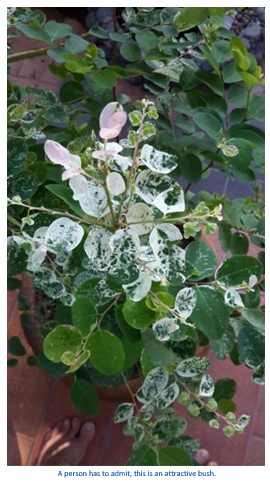By Tommy Clarkson on the August 2020 Edition
Snow Bush Breynia disticha ‘Roseo-picta’
Family Phyllanthaceae
Also known as Red-leafed Snow Bush, Redleaf Breynia, Leaf
Flower, Hawaiian Snow Bush, Snow-on-the-Mountain, Sweetpea Bush or Ice Cream Bush
The genus Breynia is comprised of evergreen trees and shrubs from tropical forests and scrub areas of Asia, Australia, and the Pacific Islands, including the Aloha State, Hawaii.
At the outset, let’s differentiate between the two, somewhat similar, varieties of this delightful species, ‘Atropurpurea’ and ‘Roseapicta’. The former has dark purple leaves, while this has mottled creamy white, pink and green variegation on its approximately one inch (2.54 cm) oval leaves, with attractive red zigzag stems and red petioles. Both are a wonderful all-season source of color. The tiny flowers, of both species which are followed by small berries generally go unnoticed. I wish I could recall where I found this description of the Snow Bush and profusely apologize to whomever said it for my non attribution to them, “It’s almost as if a watercolorist dappled each leaf with drops and blushes of color. It is bushy and upright, graceful and open.”
 The Snow Bush is native to New Caledonia and Vanuatu in the western Pacific and it’s a rather apt name for this beautiful, smallish tropical shrub though few native folks in those two locales have probably ever actually seen snow! The name is derived from the white coloration of its new growth. But, just like many a tourist to our tropics, when it gets a good dose of sus-tained sun, the young white leaves will turn to various shades of pink. Generally speaking, it is used as a specimen plant or placed in the garden as an accent what with its delightful col-oration. Some shear it and grow it as ground cover or as a bedding plant.
The Snow Bush is native to New Caledonia and Vanuatu in the western Pacific and it’s a rather apt name for this beautiful, smallish tropical shrub though few native folks in those two locales have probably ever actually seen snow! The name is derived from the white coloration of its new growth. But, just like many a tourist to our tropics, when it gets a good dose of sus-tained sun, the young white leaves will turn to various shades of pink. Generally speaking, it is used as a specimen plant or placed in the garden as an accent what with its delightful col-oration. Some shear it and grow it as ground cover or as a bedding plant.
In more tropical areas, such as ours, it is often used as a hedge. Well taken care of, in maturity, the Snow Bush should grow anywhere in the four to ten foot (1.22 – 3.05 meters) in height range with a spread of eight feet (2.44 meters). Once new growth appears, one will observe branches with leaves that are mostly green – rather than variegated.
 I’d encourage their removal as they, with the extra chlorophyll, will enlarge and grow faster than those on the rest of the plant. (Nifty nugget of knowledge: This applies to all variegated plants.) There is, by the way a small, leafed variety of this tropical shrub, called ‘Minima.’
I’d encourage their removal as they, with the extra chlorophyll, will enlarge and grow faster than those on the rest of the plant. (Nifty nugget of knowledge: This applies to all variegated plants.) There is, by the way a small, leafed variety of this tropical shrub, called ‘Minima.’
It can handle either full sun or partial shade, but develops its best foliage color in the former. Beyond that, from what I have observed, it has no serious insect or disease problems (though you might wish to keep an eye out for spider mites). Back to those bugs!
While researching the Breynia disticha, I came across an article stating that it can be a host plant for the Snowbush Caterpillar,which will evolve into the White-tipped Black Moth. Apparently, this velvety black moth is rather unique in that, unlike most nocturnal moths, it is active during the day. While I have never seen such, apparently these caterpillars can become pests and may require control to prevent them from making a meal of your plant!
Its maintenance requirements are few. They do well in well draining soil preferably organically rich with regular watering. Periodic light pruning during the growing season stimulates new foliage growth.
Additionally, one may well wish to pinch off the stem tips when they are young in order to promote branching growth. At the other end of the plant, the Snow Bush can sucker profusely and if it escapes from cultivation may spread, vegetatively, via root suckers.
 For folks who would like to have one in the more four-seasonal climes, in the winter, the Breynia disticha will attain a semi dormant state as do I in such conditions – and can lose half of its leaves. This startles and worries some, but curb those desires to over-water or prune it.
For folks who would like to have one in the more four-seasonal climes, in the winter, the Breynia disticha will attain a semi dormant state as do I in such conditions – and can lose half of its leaves. This startles and worries some, but curb those desires to over-water or prune it.
Wait until early spring and then prune off a third of each branch, feed it some with high-nitrogen fertilizer and provide it with bright, but not full – sun. Actually, partial shade would probably be best. With such actions, new growth and more col-orful leaves will soon emerge.
Lastly, for those into etymology or botanical trivia, its genus name honors Jacob Breyne (1637-1697) who was a merchant in the Polish city of Danzig called by some, Gdańsk and his son Johann Philipp Breyne (1680-1764), a physician in the same city.
—
Tommy Clarkson is a bit of a renaissance man. He’s lived and worked in locales as disparate as the 1.2 square mile island of Kwajalein to war-torn Iraq, from aboard he and Patty’s boat berthed out of Sea Bright, NJ to Thailand, Germany, Hawaii and Viet Nam; He’s taught classes and courses on creative writing and mass communications from the elementary grades to graduate level; He’s spoken to a wide array of meetings, conferences and assemblages on topics as varied as Buddhism, strategic marketing and tropical plants; In the latter category he and Patty’s recently book, “The Civilized Jungle” – written for the lay gardener – has been heralded as “the best tropical plant book in the last ten years”; And, according to Trip Advisor, their spectacular tropical creation – Ola Brisa Gardens – is the “Number One Tour destination in Manzanillo”.




